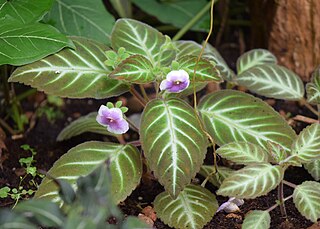Setchellanthus caeruleus is a species of pungent shrub with large blue flowers. It is placed alone in the genus Setchellanthus, which is in turn, is placed alone in the family Setchellanthaceae. It is endemic to Mexico.
Jarmania is a genus of lichenized fungi in the family Ramalinaceae. This genus was named in honour of S. Jean Jarman (b.1947), a Tasmanian botanist working in Hobart.
Ludwig Benjamin (1825–48) was a German botanist who contributed to Carl Friedrich Philipp von Martius' Flora Brasiliensis. The genus Benjaminia is named in his honour.
Horakiella is a genus of fungi within the Sclerodermataceae family that contains the two species H.clelandii and H. watarrkana.
Ridleyella is a monotypic genus of flowering plants from the orchid family, Orchidaceae. The sole species is Ridleyella paniculata, which is endemic to New Guinea.
Fischerula is a genus of two truffle-like fungi in the family Morchellaceae. First described from central Italy by Oreste Mattirolo in 1928, the genus name honors Swiss mycologist Eduard Fischer. The type species Fischerula macrospora is known only from Italy, while Fischerula subcaulis is found in coniferous and mixed forests of Oregon and Washington.

Balbisia is a genus of flowering plants belonging to the family Francoaceae. It is also in the Vivianiaceae subfamily.
Patzkea is a genus of plants in the grass family.

Uroskinnera is a genus of flowering plants belonging to the family Plantaginaceae. It is also in Tribe Cheloneae.
Thouinidium is a genus of flowering plants belonging to the family Sapindaceae.
Dahliaphyllum is a genus of flowering plants belonging to the family Apiaceae.
Dayia is a genus of flowering plants belonging to the family Polemoniaceae.
Hesseltinella is a genus of fungi belonging to the family Cunninghamellaceae.

Gloxinella is a monotypic genus of flowering plants belonging to the family Gesneriaceae. It only contains one species, Gloxinella lindeniana(Regel) Roalson & Boggan
Neomortonia is a monotypic genus of flowering plants belonging to the family Gesneriaceae. It just contains one species, Neomortonia roseaWiehler
Drummondita is a genus of flowering plants belonging to the family Rutaceae.
Neonelsonia is a monotypic genus of flowering plants belonging to the family Apiaceae. It just contains one species, Neonelsonia acuminata(Benth.) J.M.Coult. & Rose It is part of Trbie Selineae.
Rovaeanthus is a genus of flowering plants belonging to the family Rubiaceae.
Megacorax is a monotypic genus of flowering plants belonging to the family Onagraceae. The only species is Megacorax gracielanusS.González & W.L.Wagner.








